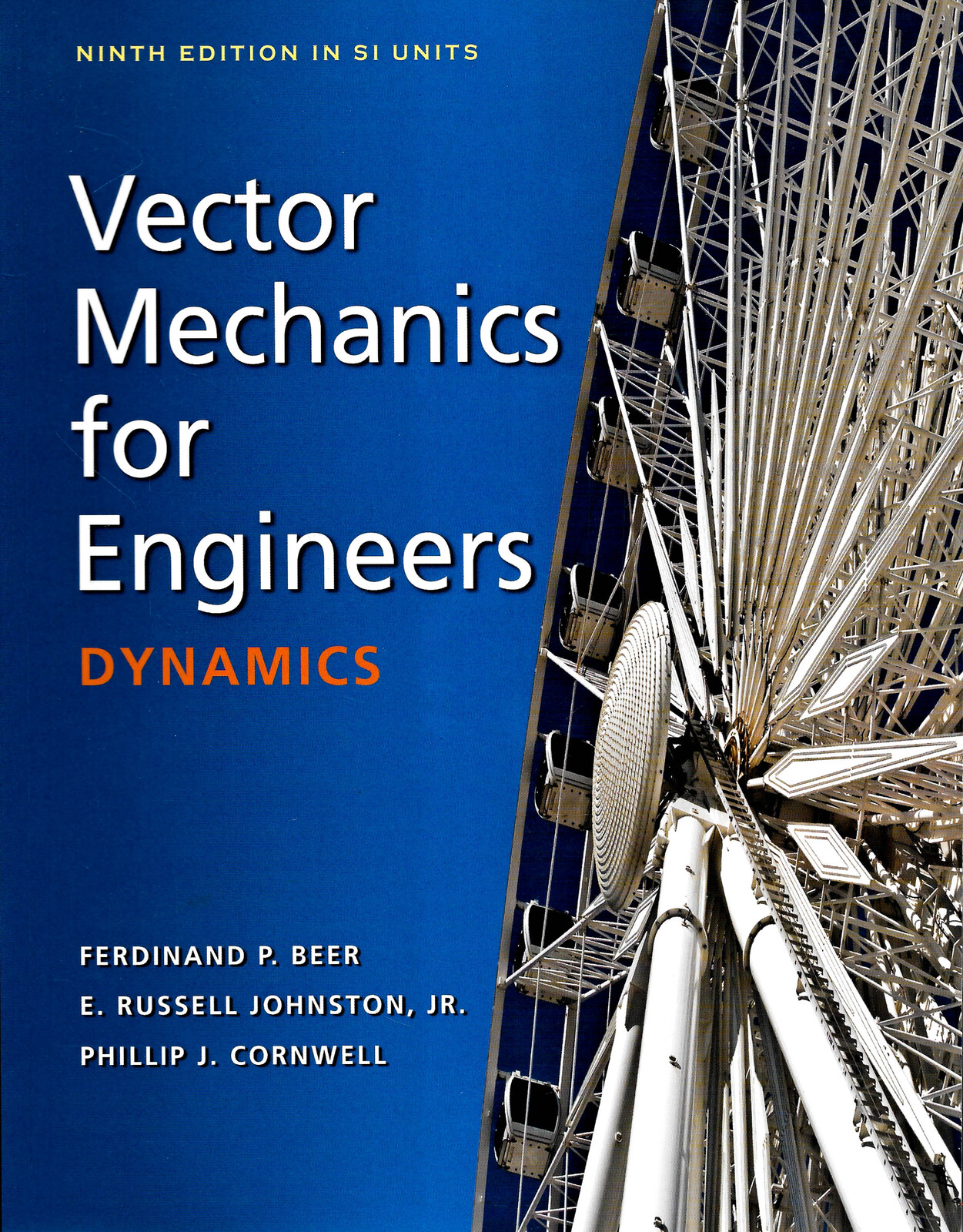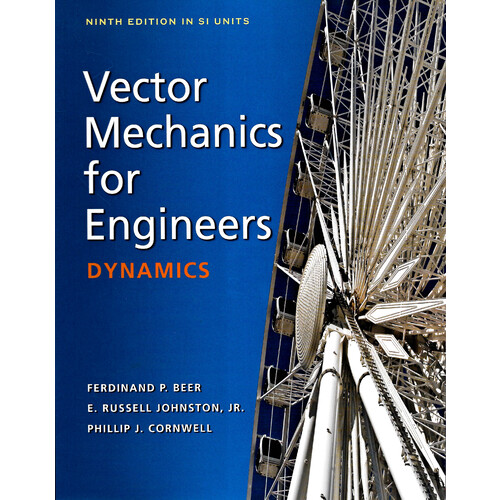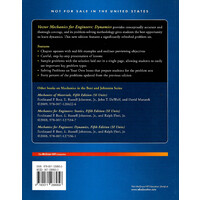Vector Mechanics for Engineers : Dynamics: SI units
Author: Ferdinand Beer,E. Johnston,Phillip Cornwell
Publisher: McGraw Hill Higher Education
Category: Mechanical Engineering & Materials
Age Group: 15+
Book Format: Paperback
Vector Mechanics for Engineers: Dynamics provides conceptually accurate and thorough coverage and its problem-solving methodology gives students the best opportunity to learn dynamics. This new edition features a significantly refreshed problem set. Key Features Chapter openers with real-life examples and outlines previewing objectives Careful step-by-step presentation of lessons Sample problems with the solution laid out in a single page allowing students to easily see important key problem types Solving Problems on Your Own boxes that prepare students for the problem sets Forty percent of the problems updated from the previous edition.
Table Of Contents
Preface
Acknowledgments
List of Symbols
Chapter 11 Kinematics of Particles
11.1 Introduction to DynamicsRectilinear Motion of Particles
11.2 Position, Velocity, and Acceleration
11.3 Determination of the Motion of a Particle
11.4 Uniform Rectilinear Motion
11.5 Uniformly Accelerated Rectilinear Motion
11.6 Motion of Several Particles
*11.7 Graphical Solution of Rectilinear-Motion Problems
*11.8 Other Graphical MethodsCurvilinear Motion of Particles
11.9 Position Vector, Velocity, and Acceleration
11.10 Derivatives of Vector Functions
11.11 Rectangular Components of Velocity and Acceleration
11.12 Motion Relative to a Frame in Translation
11.13 Tangential and Normal Components
11.14 Radial and Transverse Components
Review and Summary
Review Problems
Computer Problems
Chapter 12 Kinetics of Particles: Newton's Second Law
12.1 Introduction
12.2 Newton's Second Law of Motion
12.3 Linear Momentum of a Particle. Rate of Change of Linear Momentum
12.4 Systems of Units
12.5 Equations of Motion
12.6 Dynamic Equilibrium
12.7 Angular Momentum of a Particle. Rate of Change of Angular Momentum
12.8 Equations of Motion in Terms of Radial and Transverse Components
12.9 Motion under a Central Force. Conservation of Angular Momentum
12.10 Newton's Law of Gravitation
*12.11 Trajectory of a Particle under a Central Force
*12.12 Application to Space Mechanics
*12.13 Kepler's Laws of Planetary Motion
Review and Summary
Review Problems
Computer Problems
Chapter 13 Kinetics of Particles: Energy and Momentum Methods
13.1 Introduction
13.2 Work of a Force
13.3 Kinetic Energy of a Particle. Principle of Work and Energy
13.4 Applications of the Principle of Work and Energy
13.5 Power and Efficiency
13.6 Potential Energy
*13.7 Conservative Forces
13.8 Conservation of Energy
13.9 Motion under a Conservative Central Force. Application to Space Mechanics
13.10 Principle of Impulse and Momentum 806
13.11 Impulsive Motion
13.12 Impact
13.13 Direct Central Impact
13.14 Oblique Central Impact
13.15 Problems Involving Energy and Momentum
Review and Summary
Review Problems
Computer Problems 852
Chapter 14 Systems of Particles14.1 Introduction
14.2 Application of Newton's Laws to the Motion of a System of Particles. Effective Forces
14.3 Linear and Angular Momentum of a System of Particles
14.4 Motion of the Mass Center of a System of Particles
14.5 Angular Momentum of a System of Particles about Its Mass Center
14.6 Conservation of Momentum for a System of Particles
14.7 Kinetic Energy of a System of Particles
14.8 Work-Energy Principle. Conservation of Energy for a System of Particles
14.9 Principle of Impulse and Momentum for a System of Particles
*14.10 Variable Systems of Particles
*14.11 Steady Stream of Particles
*14.12 Systems Gaining or Losing Mass
Review and Summary
Review Problems
Computer Problems
Chapter 15 Kinematics of Rigid Bodies
15.1 Introduction
15.2 Translation
15.3 Rotation about a Fixed Axis
15.4 Equations Defining the Rotation of a Rigid Body about a Fixed Axis
15.5 General Plane Motion
15.6 Absolute and Relative Velocity in Plane Motion
15.7 Instantaneous Center of Rotation in Plane Motion
15.8 Absolute and Relative Acceleration in Plane Motion
*15.9 Analysis of Plane Motion in Terms of a Parameter
15.10 Rate of Change of a Vector with Respect to a Rotating Frame
15.11 Plane Motion of a Particle Relative to a Rotating Frame. Coriolis Acceleration
*15.12 Motion about a Fixed Point 984
*15.13 General Motion 987
*15.14 Three-Dimensional Motion of a Particle Relative to a Rotating Frame. Coriolis Acceleration
*15.15 Frame of Reference in General Motion
Review and Summary
Review Problems
Computer Problems
Chapter 16 Plane Motion of Rigid Bodies: Forces and Accelerations
16.1 Introduction
16.2 Equations of Motion for a Rigid Body
16.3 Angular Momentum of a Rigid Body in Plane Motion
16.4 Plane Motion of a Rigid Body. D'Alembert's Principle
*16.5 A Remark on the Axioms of the Mechanics of Rigid Bodies
16.6 Solution of Problems Involving the Motion of a Rigid Body
16.7 Systems of Rigid Bodies
16.8 Constrained Plane Motion
Review and Summary
Review Problems
Computer Problems 1079
Chapter 17 Plane Motion of Rigid Bodies: Energy and Momentum Methods
17.1 Introduction
17.2 Principle of Work and Energy for a Rigid Body
17.3 Work of Forces Acting on a Rigid Body
17.4 Kinetic Energy of a Rigid Body in Plane Motion
17.5 Systems of Rigid Bodies
17.6 Conservation of Energy
17.7 Power
17.8 Principle of Impulse and Momentum for the Plane Motion of a Rigid Body
17.9 Systems of Rigid Bodies
17.10 Conservation of Angular Momentum
17.11 Impulsive Motion
17.12 Eccentric Impact
Review and Summary
Review Problems
Computer Problems
Chapter 18 Kinetics of Rigid Bodies in Three Dimensions
*18.1 Introduction
*18.2 Angular Momentum of a Rigid Body in Three Dimensions
*18.3 Application of the Principle of Impulse and Momentum to the Three-Dimensional Motion of a Rigid Body
*18.4 Kinetic Energy of a Rigid Body in Three Dimensions
*18.5 Motion of a Rigid Body in Three Dimensions
*18.6 Euler's Equations of Motion. Extension of D'Alembert's Principle to the Motion of a Rigid Body in Three Dimensions
*18.7 Motion of a Rigid Body about a Fixed Point
*18.8 Rotation of a Rigid Body about a Fixed Axis
*18.9 Motion of a Gyroscope. Eulerian Angles
*18.10 Steady Precession of a Gyroscope
*18.11 Motion of an Axisymmetrical Body under No Force
Review and Summary
Review Problems
Computer Problems
Chapter 19 Mechanical Vibrations
19.1 IntroductionVibrations without Damping
19.2 Free Vibrations of Particles. Simple Harmonic Motion
19.3 Simple Pendulum (Approximate Solution)
*19.4 Simple Pendulum (Exact Solution)
19.5 Free Vibrations of Rigid Bodies
19.6 Application of the Principle of Conservation of Energy
19.7 Forced VibrationsDamped Vibrations
*19.8 Damped Free Vibrations
*19.9 Damped Forced Vibrations
*19.10 Electrical Analogues
Review and Summary
Review Problems
Computer Problems
Appendix A Some Useful Definitions and Properties of Vector Algebra
Appendix B Moments of Inertia of Masses
Appendix C Fundamentals of Engineering Examination
Photo Credits
Index
Answers to Problems
About Ferdinand Beer
Born in France and educated in France and Switzerland, Ferdinand Beer held an M.S. degree from the Sorbonne and an Sc.D. degree in theoretical mechanics from the University of Geneva. He came to the United States after serving in the French army during the early part of World War II and taught for four years at Williams College in the Williams-MIT joint arts and engineering program. Following his service at Williams College, Beer joined the faculty of Lehigh University, where he taught for thirty-seven years. He held several positions, including the University Distinguished Professors Chair and Chairman of the Mechanical Engineering and Mechanics Department. In 1995, Beer was awarded an honorary Doctor of Engineering degree by Lehigh University.
Born in Philadelphia, Russell Johnston holds a B.S. degree in civil engineering from the University of Delaware and an Sc.D. degree in the field of structural engineering from The Massachusetts Institute of Technology (MIT). He taught at Lehigh University and Worchester Polytechnic Institute (WPI) before joining the faculty of the University of Connecticut, where he held the position of Chairman of the Civil Engineering Department and taught for twenty-six years. In 1991, Johnston received the Outstanding Civil Engineer Award from the Connecticut Section of the American Society of Civil Engineers.
Phillip J. Cornwell holds a B.S. degree in mechanical engineering from Texas Tech University and M.A. and Ph.D. degrees in mechanical and aerospace engineering from Princeton University. He is currently a professor of mechanical engineering at Rose-Hulman Institute of Technology, where he has taught since 1989. His present interests include structural dynamics, structural health monitoring, and undergraduate engineering education. Cornwell spends his summers working at Los Alamos National Laboratory, where he is a mentor in the Los Alamos Dynamics Summer School and does research in the area of structural health monitoring. He received an SAE Ralph R. Teetor Educational Award in 1992, the Dean's Outstanding Scholar Award at Rose-Hulman in 2000, and the Board of Trustees Outstanding Scholar Award at Rose-Hulman in 2001.
| SKU | BK-9780071288958 |
| Barcode # | 9780071288958 |
| Brand | McGraw Hill Higher Education |
| Artist / Author | Ferdinand Beer, E. Johnston, Phillip Cornwell |
| Shipping Weight | 1.3200kg |
| Shipping Width | 0.200m |
| Shipping Height | 0.030m |
| Shipping Length | 0.250m |
| Assembled Length | 25.400m |
| Assembled Height | 2.600m |
| Assembled Width | 20.000m |
| Type | Paperback |





